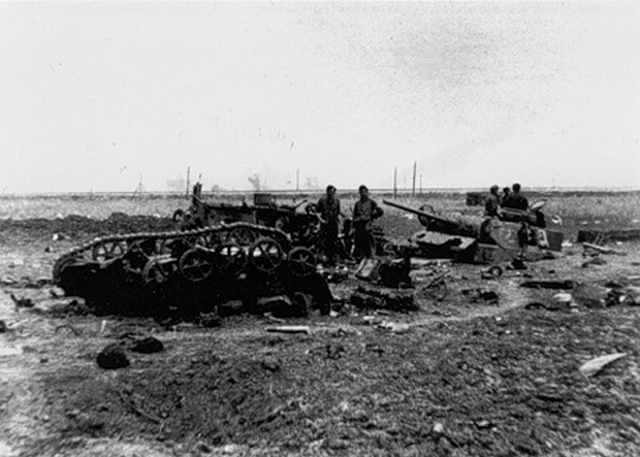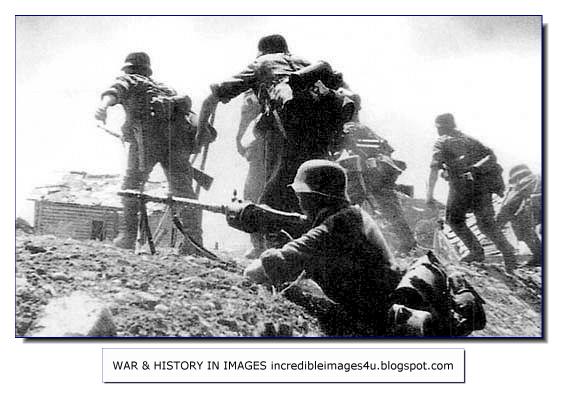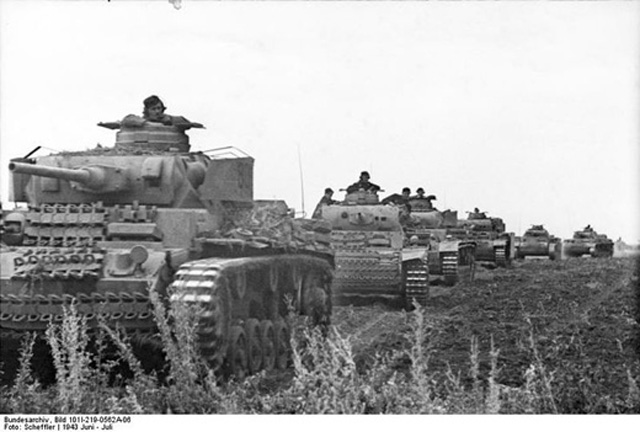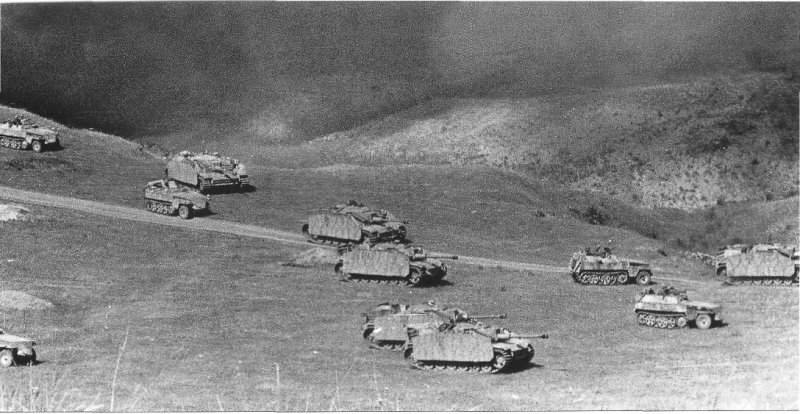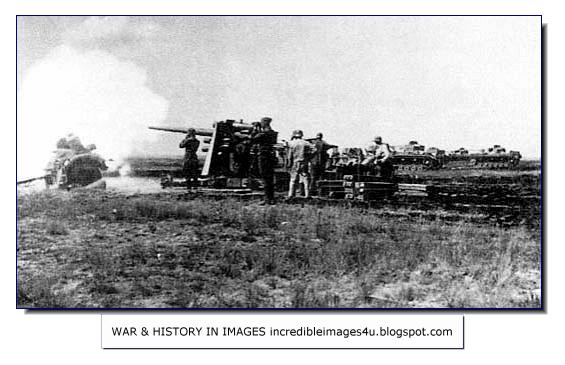Air Operations, Europe
RAF BOMBER COMMANDEvening Ops:
- 5 Mosquitos are sent to Cologne and 4 more to Hamburg. 34 aircraft lay mines off the French ports and in the Frisians and there are 18 OTU sorties. 1 Stirling and 1 Wellington are lost in mine-laying operations.
Air Operations, Mediterranean
B-17s and Spitfires engage 100 German and Italian fighters over Gerbini airfield on Sicily. The top Italian 'ace' Capt Franco Lucchini, 26 victories, is shot down and killed.
[Air Operations, New Guinea
V Bomber Command B-25s attack the airfield at Salamaua, 2 Japanese Army headquarters, and a trail.
[Air Operations, Sicily
- NASAF B-17s, B-25s, and B-26s attack various parts of the Gerbini Airdrome complex and the radar stations at Licata and Marsala.
- NATAF aircraft attack the Biscari, Comiso, Sciacca, and Trapani/Milo Airdromes.
- 86 IX Bomber Command B-24s attack port facilities, oil storage, and rail yards at Messina.
- IX Bomber Command B-25s attack the Biscari and Sciacca Airdromes.
- In the most heavily opposed bombing mission of the pre-invasion bombing cycle, 27 B-17s of NASAF's 99th Heavy Bomb Group bound for the Gerbini Airdrome complex are attacked by an estimated 100 Axis fighters. The formation succeeds in dropping 3,240 fragmentation bombs on the airdrome, resulting in damage or loss to an estimated 28 Axis fighter on the ground. Bomber gunners claim 38 fighters downed and 11 probables, but these are certainly liberal estimates. P-38s of the 82nd Fighter Group down 5 Axis fighters.
- 3 B-17s are lost
Air Operations, Solomons
- 9 XIII Bomber Command B-24s on an antishipping strike to the Buin area fail to locate targets, so they attack the airfield at Ballale and the Munda Point airfield on New Georgia. This is the first strike force able to reach the northern Solomons in weeks on account of continuously bad weather.
- P-40s of the 18th Fighter Groupís 44th Fighter Squadron down two A6M Zeros over Munda and Rendova between 1245 and 1330 hours.
Allied Planning
The JCS receives the COSSAC OVERLORD concept of operations based on the planning guidelines provided by the CCS after the Trident Conference. In COSSAC's assessment, the Pas-de-Calais area of France, even though the shortest and most sustainable site for an invasion, is also the most heaviley defended. The Cotentin Peninsula has poor terrain for establishing and sustaining a lodgment, but the port of Cherbourg could provide the Allies with facilities to bring in supplies. Caen has a good port, is weakly defended, and has good surrounding terrain that can support airfields. It also has good defensive terrain to protect a beachhead. Based on this analysis, COSSAC recommends Caen as the site for the cross-Channel invasion. The staff notes that not matter what site is chose, the destruction of the German air force is essential--not only the enemy's current fighter strength, but also fighter production facilities. The COSSAC planners have examined using airborne and amphibious forces to establish a beachhead at Caen (designated as D-day), followed by the seizure of Cherbourg 14 days after the initial landings (D+14). The Allies will have 18 division landed in France and 18 airfields operational by this time. By D+50, planners estimate 30 divisions in France. After this buildup, the Allies will attack to capture Paris and the Seine River ports, followed by an advance into Belgium and northern France.
[Battle of the Atlantic
- Returning from patrol with two other U-boats, the three subarines are spotted by Liberatro 'G' of No 53 Squadron. U-535 is sunk by the aircraft becoming damaged in the process.
- The US freighter Maltran, in Convoy GTMO-134 and en route from Guantanamo Bay, Cuba to Ponce, Puerto Rico, is torpedoed and sunk by U-759. Submarine chaser SC-1279 rescues all hands, 35 crewmen and 12 Armed Guard sailors.
| Class | Type IXC/40 |
| CO | Kapitänleutnant Helmut Ellmennreich |
| Location | Atlantic, NE of Cape Finisterre |
| Cause | Air attack |
| Casualties | 55 |
| Survivors | None |
Indian Ocean
The US freighter Alcoa Prospector (6797t), in Convoy PA-44 and en route from Abadan, Iran to Montevideo, Uruguay, is torpedoed by Japanese submarine I-27. The Royal Indian Navy minesweeper Rins Bengal rescues the survivors. The crew will reboard the Alcoa Prospector the next day as the Indian ship stands by.
[Mediterranean
U-593 sinks 2 US LSTs and 1 merchant ship off the Algerian coast.
[New Georgia
The Northern Landing Group, composed of the 1st Marine Raider Battalion and a battalion each of the 145th and 148th Infantry Regiments, 37th Infantry Division, under command of Maine Col Harry B. Liversedge, lands in a heavy rain at Rice Anchorage. The group's mission is to conduct a landing in northern New Georgia, attack Japanese positions at Enogai Inlet, and capture Bairoko Harbor to prevent Japanese reinforcements and supplies from reaching the defenders at Munda. Lightly armed and with three days' rations, the men struggle inland through dense juncle.
During a commander's meeting, Maj-Gen Millard Harmon request Maj-Gen Oscar Griswold's XIV Corps headquarter to be deployed to assist the over-stretched 43rd Infantry Division staff, which is attempting to serve as both ground command for Adm Kelly Turner and the command element for the New Georgia Occupation Force. Adm Halsey gives his approval.
[Secret War
Russian forces in the Kursk salient have long been preparing to meet the German onslaught thanks to reports from the 'Lucy' spy ring in Germany.
[Solomons
The main body of American troops is concentrated on Rendova, where there is a Japanese garrison 6,000 strong. 4 battalions of US troops from the 43rd Inf Div land in the north of New Georgia at Rice Anchorage not far from Bairoko, and advance elements reach the Giza Giza River. The fighting on the Zanana-Munda track continues.
During the night 3 groups of Japanese destroyers, 10 ships in all, bring 850 men to Kolombangara from the Shortlands and ?? almost 3,000 more troops to Vila. As soon as the operation is completed the 'Tokyo Night Express', which has never been out of action even if it has ceased to be the main supply line to Guadalcanal, leaves immediately. It is intercepted, howver, in the Gulf of Kula by a force under Rear-Adm Walden L. Ainsworth of 3 cruisers and 4 destroyers. A battle flares up and the Americans get the worst of the engagement. They lose the light cruiser Helena (CL-50) and the destroyer Strong (DD-467), sunk by a submarine, while the Japanese lose 2 destroyers, the Niizuki and Nagatsuki, the latter grounded and finished off at dawn by American aircraft.
[